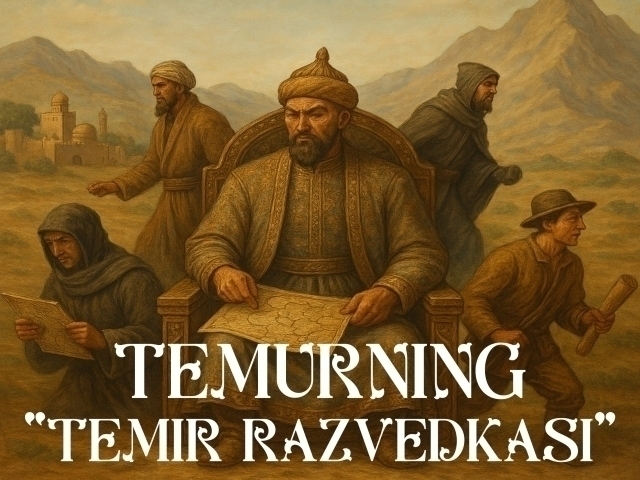Амир Темурнинг “темир разведкаси”: барча томонлардаги айғоқчи ва жосуслар
Таҳлил
−
11 Апрель 26455 5 дақиқа
Куни кеча, 9 апрелда Соҳибқирон Амир Темур таваллудига 689 йил тўлди. У ўзи олиб борган жанглар давомида турли ҳарбий стратегик тактикалардан фойдаланиб, қўшинига ғалаба келтирган. Манбаларни ўрганган тарихшуносларга кўра, Темур кучли ақл ва ташкилотчилик қобилиятига эга бўлган. У кичик гуруҳлар (ўнлик, юзлик)га тақсимлаш йўли билан бутун қўшинни доимий назоратда ушлаб тура олган. Шунингдек, Темур яратган разведка кучли тизимга айланиб, стратегик қарорлар қабул қилишда унга асос бўлган. Мақолада Амир Темурнинг разведка ва ҳарбий стратегияси ҳақида сўз боради.
Савдогардан қаландаргача: Темурнинг жосуслари кимлар эди?
Тарих фанлари доктори Ҳамдам Содиқов ўзининг 25 йил давомида ёзилган “Амир Темур салтанатининг хавфсизлик хизмати” тарихий бадиа(тарихий воқеалар, шахслар ёки даврлар асосида яратилган адабий асар)сида шундай дейди:
“Жосусларнинг буниси Қоҳирада, Муизияда бўлса, униси Дамашқда, Шамийсониядаги сўфийлардан бири эди. Улардан бири чаканафуруш бўлса, иккинчиси йирик савдогар, бадхулқ полвон ва бузуқи дорбоз, жафокор ва ҳунарманд, мунажжим ва ўз табиатича иш қиладиган, гапчиноз қаландарлару саёқ дарвешлар, денгизчи маллоҳлару қуруқликдаги сайёҳлар, зарофатли мешкоблар, латофатли этикдўзлар, алвасти ва ҳийлакор Далла мисоли фирибгар кампирлар тажрибаси бўлиб, илм талабида мағрибу машриқни кезган, пайига тушган мақсад йўлида макру ҳийла маконида камолга етган, ўзининг нозик фириби ва даҳоси билан, сув билан олов, тўғрилик билан эгрилик ўртасида униб ўсган, макру ҳийлада Сосон ва Абу Зейддан ҳам ўтиб кетган, икки мухолифни бир-бирига бириктириб, икки душманни бир-бирига қўшган уддабурон кишилар эди”.
Амир Темур ҳақида кўплаб маълумотлар ёзиб қолдирган унинг замондоши Ибн Арабшоҳ Темур разведкаси ҳақида шундай дейди:
“У барча томонларга ўз айғоқчиларини тарқатиб, қолган мулкларига эса жосуслар қўйган эди”.
.jpg)
Ҳамдам Содиқовга кўра, Ибн Арабшоҳ Темурнинг жосуслари чор-атрофда бўлаётган ҳодисалар ва уларнинг хабарларини мунтазам етказиб тургани ва ҳатто шаҳарлар суратини чизиб кўрсатганини ёзиб қолдирган. Улар кузатилаётган манзилнинг географияси, бошлиқлари, бойлари ва ҳурматга сазовор бошқа шахслар ҳақида маълумот тўплаган.
Шунингдек, Ибн Арабшоҳга кўра, Темур аскарлари орасида бутпараст турклар, оловга сажда қилувчи мажусий ажамлар, коҳинлар ва сеҳргар кабилар ҳам бўлган. Тарихчининг ёзишича, улар Темурга хизмат қилишдан шунчалик фахрланганки, агар у пайғамбарлик ёки илоҳийликка даъво қилса, буни тасдиқлаш даражасида бўлган.
Ҳамдам Содиқов ўзининг китобида келтирилишича, Амир Отламиш, Маъсудбек ва Азизуддин кабилар Темур разведкасида муҳим ўрин тутувчи шахслар бўлган ва унга бутун дунёдан келган маълумотларни умумлаштириб, етказиб турган.
Рельефга кўра алоҳида ҳарбий қисим
Профессор Ҳамидулла Дадабоевнинг ёзишича, Соҳибқирон интизомли армия тузишга, жанг пайтида қўшин қисмларини оқилона бошқаришга ва жанговар руҳни баланд ушлаб туришга эриша олган. Темур Шарқда биринчилардан бўлиб армияга ўт сочар қурол (тўп)ни олиб кирган. Тоғли ҳудудларда жанг ҳаракатлари олиб бориш учун махсус ҳарбий қисм ва бўлинмалар ташкил қилган. Дадабоевга кўра, қисмларнинг жанггоҳда ёки жанговар сафда талаб даражасида ҳаракат қилиши учун зарур тадбир ва чоралар ишлаб чиқилган, уларни жанг пайтида тезкорлик билан бошқаришга алоҳида диққат қаратилган. Ўнлик, юзлик, минглик ва туман қўмондонларини танлаш масаласига олий бош қўмондон масъул ҳисобланган. Соҳибқироннинг ҳарбий санъат ривожига қўшган улкан хизматларидан яна бири – жанг вақтида қўшин қанотларини душман ҳужумидан муҳофаза қилиш ва, ўз навбатида, ғаним кучларини ён томондан айланиб ўтиб, унга ортдан зарба бериш мақсадида тузилган отлиқ қисм – қунбулнинг жорий этилиши бўлган. Бундай янги ҳарбий қисм Александр, Ганнибал, Чингизхон, Людовик XIV, Буюк Фридрих каби атоқли саркардалар қўшинида бўлмаган.
Қўшин тўплаш ҳақида махсус буйруқ (тунқол) эълон қилингач, ҳукмдор томонидан тузилган рўйхатга биноан жангчилар от-улови, қурол-яроғи, озиқ-овқати, ем-хашаги билан тўпланиш ерига етиб келган. Ҳар бир аскарга битта ёй, 30 та ўқ, бир садоқ, битта қалқон, битта қўшимча от, ярим ман оғирлигида арқон, тери халта ва битта қозон ажратилган. Ҳар 10 жангчи бир чодир, 2 белкурак, бир керки, битта ўроқ, бир арра, бир теша, битта болта ва 100 дона нина олиб юриши шарт ҳисобланган. Сара жангчиларнинг ҳар 5 таси битта чодирга жойлашган. Ўнбегининг алоҳида чодири ва 5 та қўшимча оти бўлган. Юзбегига ҳам алоҳида чодир ва 10 та қўшимча от берилган. Мингбеги чодирдан ташқари соябон билан ҳам таъминланган. Соҳибқирон армиясининг турли бўлинма ва қисмларига 313 бек бошчилик қилган. Улардан дастлабки 100 таси ўнбегилик, иккинчи 100 таси юзбегилик, учинчи 100 таси мингбегилик лавозимларини эгаллаган.
Дивизия – туманларга Амир Темурнинг фарзандлари, набиралари ва номдор лашкарбошилар раҳбарлик қилган. Етарли миқдорда қўшин тўплангач, у кўрикдан ўтказилган. Темурийлар даврида юриш ёки жангдан олдин лашкарни кўрикдан ўтказиб, унинг жанговар руҳи ва ҳолатини аниқлаш изчилликка айланган.
Новатор Темурнинг ҳарбий тактикаси
Тарихчилар маълумотларига кўра, Амир Темурнинг 12 минг кишилик қўшини жангга мана бундай тартибда кирган. Душман билан дастлабки тўқнашувни айғоқчилик билан машғул бўлган қаравул бошлаб берган. Шундан кейин ўнг ва чап қанот илғор қисмлари – баранғор ҳировули ва жуванғар ҳировули мададида асосий илғор қисм – манғлай жангга кирган. Манғлай ортидан баранғор ҳамда жуванғарнинг қолган 2 бўлаги – чапавул ва шағавул кетма-кет ҳаракатга келган. Ушбу кучлар душманни мағлуб этишга кифоя қилмаса, бош қўмондон бошчилигидаги марказ (қўл) ҳал қилувчи ҳужумга ташланган.
Тарихий манбаларда қайд этилишича, Соҳибқирон армияси қатнашган улкан жангларнинг тактик бориш манзараси қуйидагича бўлган: қўшин маркази 40 бўлук – полкка тақсимланган ва Олий бош қўмондонга итоат қилган. Ушбу бўлукларнинг сара жангчилардан ташкил топган 12 бўлуки сафнинг биринчи қаторида, қолган 28 бўлуки иккинчи ва учинчи қаторларда жойлашган. Қирқ бўлукнинг ўнг тарафи олдида амирзодалар қисмлари, сўл тарафи олдида қариндошлар ва иттифоқчилар қисмлари саф тортган. Иккинчи қаторнинг баранғорида 6 бўлук ўз илғори – ҳировул билан ўрин эгаллаган. Айни шу миқдордаги бўлук ва ҳировулга жуванғар ҳам эга бўлган. Иккинчи қатор баранғори ва жуванғари олдида юқоридаги тартибда биринчи қатор қисмлари жойлашган. Унинг олдида бош манғлай (қўшиннинг илғор қисми) ҳаракатда бўлган. Енгил суворийлардан иборат 2 бўлук армияни қўққисдан бўладиган ҳамладан муҳофаза қилиш, душман кучлари ҳаракатини кузатиш билан банд бўлган.
Хулоса ўрнида айтиш мумкинки, Амир Темур шахси ва сиёсати асрдан ошиқки, дунё учун қизиқ ва ҳайратланарлилигича қолмоқда.
Live
Барчаси




